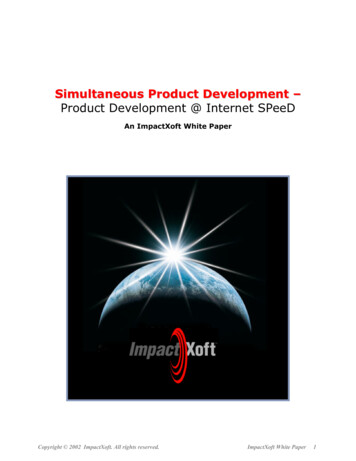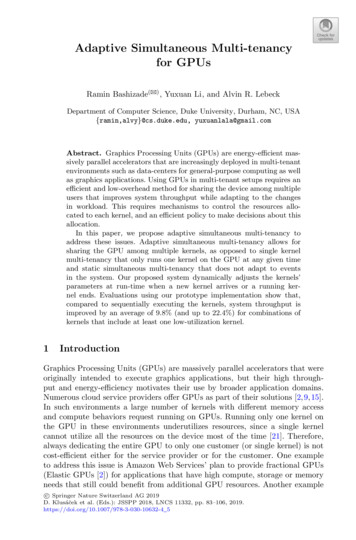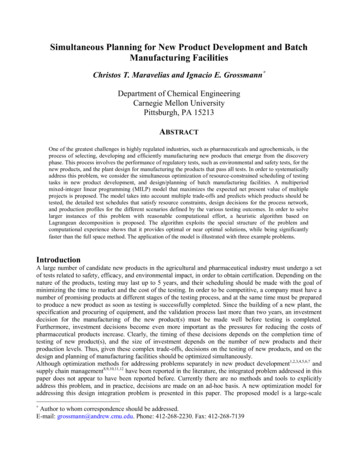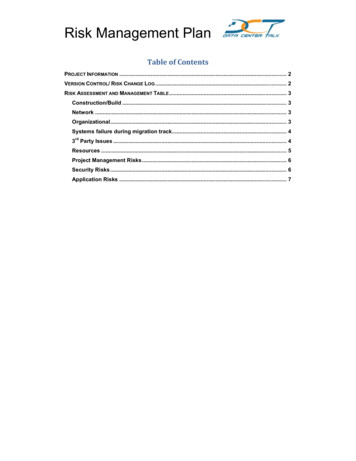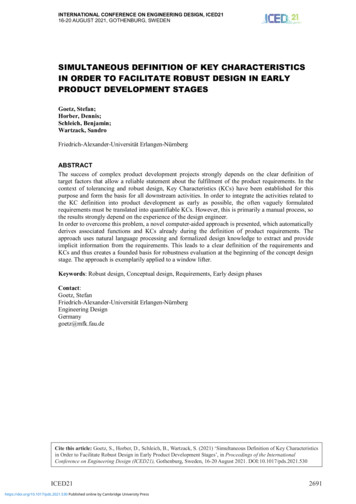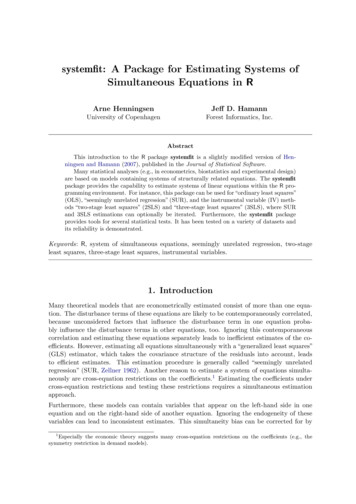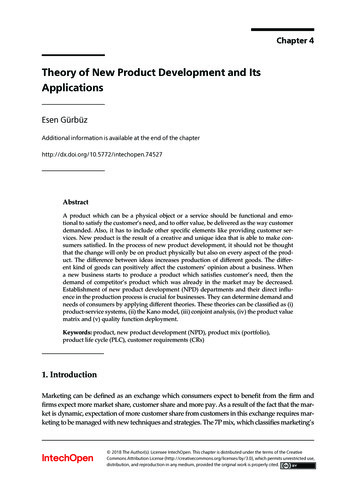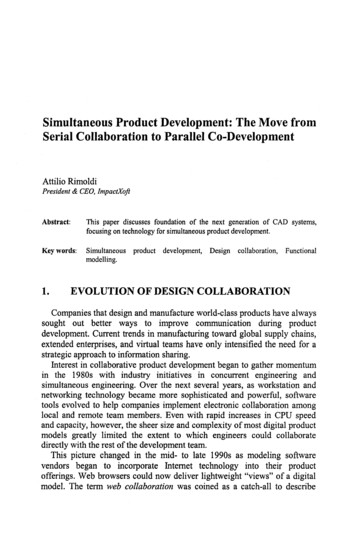
Transcription
Simultaneous Product Development: The Move fromSerial Collaboration to Parallel Co-DevelopmentAttilio RimoldiPresident & CEO, ImpactXoftAbstract:This paper discusses foundation of the next generation of CAD systems,focusing on technology for simultaneous product development.Key words:Simultaneous product development,modelling.1.Design collaboration,FunctionalEVOLUTION OF DESIGN COLLABORATIONCompanies that design and manufacture world-class products have alwayssought out better ways to improve communication during productdevelopment. Current trends in manufacturing toward global supply chains,extended enterprises, and virtual teams have only intensified the need for astrategic approach to information sharing.Interest in collaborative product development began to gather momentumin the 1980s with industry initiatives in concurrent engineering andsimultaneous engineering. Over the next several years, as workstation andnetworking technology became more sophisticated and powerful, softwaretools evolved to help companies implement electronic collaboration amonglocal and remote team members. Even with rapid increases in CPU speedand capacity, however, the sheer size and complexity of most digital productmodels greatly limited the extent to which engineers could collaboratedirectly with the rest of the development team.This picture changed in the mid- to late 1990s as modeling softwarevendors began to incorporate Internet technology into their productofferings. Web browsers could now deliver lightweight "views" of a digitalmodel. The term web collaboration was coined as a catch-all to describe
4A. Rimoldimany different kinds of activities that a product development team mightengage in when sharing ideas, such as online viewing and markup,automated workflow and email notifications, interactive design reviews, andthe like.Web collaboration tools represent movement forward, but they fall shortfor companies that wish to implement a strategy for developing products inInternet time.Manufacturers are increasingly decentralized. Strategic partnerships andvirtual corporations are commonplace. In supply chains, OEMs delegatemore design responsibility to subcontractors. Product development teams areno longer made up exclusively of designers and engineers but includerepresentatives from manufacturing, industrial design, and other disciplines.Distributed teams collaborate throughout the product life cycle, definingconfigurations and making engineering changes from the conceptual stagesof design until the time when the product is no longer in service.ImpactXoft responds to the demand in the design and manufacturingcommunity for tools that enable dispersed multidisciplinary productdevelopment teams to work more quickly and more efficiently. Designcollaboration is now a business driver.2.THE NEXT STEP: SIMULTANEOUS PRODUCTDEVELOPMENTSimultaneous Product Development, or SPD, is a method of designcollaboration in which members of the entire global development chain workin parallel, synchronously or asynchronously, to create and finalize productdefinitions. Simultaneous means at the same time. Companies that practiceSimultaneous Product Development achieve the closest possiblecollaboration between designers and the rest of the development chain.Simultaneous Product Development shifts the paradigm for collaborativeproduct design. Up to now, collaborative practices have been serial andalternating, not parallel and simultaneous. In serial collaboration, copies ofdigital product files are passed back and forth like a baton amongdevelopment team members who must wait to get the baton back before theycan make or even suggest design refinements. View-and-markup sessionsbog down while MODELING specialists incorporate changes andregenerate a separate master model. Days and weeks pass as a designprogresses serially along these steps in the development life cycle.ImpactXoft has created the IX SPeeD Suite of software expressly tosupport the practice of Simultaneous Product Development. The softwareopens the full functionality of digital modeling to any participant in thedevelopment process. All the specialists in product development, regardless
Simultaneous Product Development5of location or role, can work together simultaneously in order to define andcorrect design intent.3.KEY TECHNOLOGY SERVES AS THEFOUNDATION FOR SIMULTANEOUS PRODUCTDEVELOPMENTThree interdependent ImpactXoft technologies underlie the IX SPeeDSuite. These technologies make Simultaneous Product Developmentpossible:IX Functional ModelingTM. Described in further detail later, it is a uniqueapproach to modeling that lets designers focus on the required functionalityof the product instead of the details of geometry creation. As a result,technical and non-technical members of the development team can easilyrefine product definitions.IX Functional Object Representation (FOR). Described in further detaillater, it is an ingenious solution to the problem of sharing over the Internetthe large digital files typical of digital models. Rather than simplify productmodels to reduce their size, and thus eliminate important details, FORtechnology captures the inherent properties of each design element and theirplace and purpose within a model. The FOR for each digital model isexpressed as a small bundle of intelligent data. It is used as the vehicle forcommunicating design information and instructions over connections evenlower than 28.8 kbps.IX Design Intent Merge (DIM). Using this DIM technology, the FORbundle provided by functional modeling is communicated among projectmembers and merged on their respective desktops to instantly integrate thechanges on the fully functional model.ImpactXoft's Functional Object Representation and Design Intent Mergelighten the process of electronic collaboration. These two technologiesdepend on the simplified approach to building geometry that is inherent toFunctional Modeling.
64.A. RimoldiFUNCTIONAL MODELING TECHNOLOGYANSWERS THE NEED FOR A NEW APPROACHTO DESIGN AUTHORINGImpactXoft's invention of Functional Modeling began with a long look atcurrent modeling tools in the context of intensified calls for supply chaincollaboration. The conclusion was undeniable: many modeling systemsrepresent the principal bottleneck to collaboration between engineering andthe rest of the product development team. In order for companies toimplement productive strategies for collaborative product development,design authoring itself had to change.ImpactXoft's Functional Modeling is the technology that allows engineersto design more in accordance with the way they think - that is, to addfeatures to parts and to build models intuitively, without having to satisfy theconstraints of geometric or history-based modeling systems.Design authoring tools have always catered to mathematicians. Manyengineers design for mathematical precision rather than the functionality ofthe end product. Due to the complicated mathematics of existing systems, aproduct's design can have flawless geometry but still be difficult orimpossible to manufacture. The fundamental technology behind FunctionalModeling solves this problem. ImpactXoft's modeling software incorporatesadvanced generative geometry which allows industry specialists to designwith the functionality of the model in mind, thus liberating them from theoppression of geometric modeling.Functional Modeling technology makes it possible for the system toautomatically infer and maintain associative relationships between all designelements. There is no need to make or break parent-child relationships inorder to move elements around within a design. If one element changes, anyelements associated with it are automatically updated to maintain a fullyfunctional model.Since cutrent modeling systems impose a modeling process based on anencumbering history tree, engineers and designers have a fundamentalproblem. The drawback of history-based modeling is that it limits creativityand productivity by placing strict rules on the order in which model elementscan be implemented and changed. In order to change one model component,an engineer may have to backtrack through the model's entire history. Toooften they find themselves navigating and rearranging model history treesinstead of concentrating on design intent.Functional modeling is a breakthrough when it comes to historyindependence and makes it easy to edit, manipulate and change a design, nomatter what stage it is in. Engineers can use the tool intuitively .and applymodeling operations where and when they desire. Because FunctionalModeling is history independent, designers can implement and change
Simultaneous Product Development7design elements at any stage in the model life cycle, regardless of the orderof operation. Rather than spending time devising system workarounds,engineers can focus on fulfilling their vision for the end product.A key component of ImpactXoft's Functional Modeling approach is itsintroduction of behavioral features. Each of these features embodies aspecific behavior with various options. To apply a feature is to apply anelement with a unique behavior while leaving the system to create theresulting geometry. With this approach, engineers can use the feature theyneed without worrying about how it was constructed. The modeling processis streamlined, and the end product is a design based on the specificbehaviors of the parts.Without the unique aspects of Functional Modeling, SiinultaneousProduct Development could never exist. It is the fundamental way thatmodels are created that enables a new method of collaboration.5.SIMULTANEOUS PRODUCT DEVELOPMENTBENEFITS COMPANIES THAT DESIGN ANDMANUFACTURE PRODUCTSBecause SPD simplifies the design process and promotes earlycollaboration, it boosts products through the development cycle and savescompanies time and money.SPD also simplifies the modeling process by building a collaborationbridge to the engineering "island." Design activities today are oftencomplicated by the fact that engineers work in software systems that areisolated from the rest of the development team. Engineering organizationshave long understood that early and ongoing feedback about requirements,manufacturing, testing, service, and so on results in better and more costeffective product models. However, hard-to-use modeling software hastraditionally prevented manufacturers, suppliers, marketers, and otherdevelopment team members from providing feedback at vital decisionmaking moments during the product modeling phase. Costly engineeringchange orders and late-stage design changes stall product releases and are aconstant problem in the development chain.Simultaneous Product Development minimizes expensive late-stagedesign revisions because the entire development team is continually engagedin a product's definition. Manufacturers, suppliers, and even customers areequipped with easy-to-use modeling tools and can evaluate and makechanges to the product design. Complete input in the early stages of designcan greatly reduce the amount of time and cost it takes to bring products tomarket. Shedding one or two weeks from the development cycle savesmanufacturing companies millions of dollars.
8A. RimoldiImpactXoft's tools for SPD open the door to the engineering realm byproviding a means for fast, efficient, and complete collaboration. BecauseImpactXoft's authoring tool simplifies the design process and reduces theemphasis on geometry creation, even novices can easily revise the originalmodel.6.NEW OPTIONS FOR COMPANIES THAT WISHTO PRACTICE SIMULTANEOUS PRODUCTDEVELOPMENTImpactXoft is redefining the whole meaning of collaboration. As statedearlier, simultaneous means at the same time. Unless designers and othermembers of the development chain can work on the same digital model atthe same time, their productivity is a fraction of what it could be. The IXSPeeD Suite fills that final gap in productivity by allowing project membersaround the globe to simultaneously revise the same model. Most importantly,team members are engaged in revising the actual geometry of the model, notperforming mere redlining or markup.The IX SPeeD Suite provides tools for two new modes of collaboration inSimultaneous Product Development:In synchronous mode, project members work together on their ownmanifestations of the same model in real time, performing, sharing, andinstantly merging their modeling operations.In asynchronous mode, project members work on their own tasks offlineand can share, receive, and merge modeling operations whenever theychoose to go online.These new options for design collaboration are made possible by theInternet-centric architecture of ImpactXoft's tools and the interplay ofFunctional Modeling, Functional Object Representation, and Design IntentMerge seminal technologies.Each product specialist, regardless of location or role, is equipped withhands-on modeling software and can quickly define or correct the designintent represented in a digital model. Participants experience the designsession as if they are all on the same computer, but with the advantage ofbeing able to work on their own tasks. There is no need to wait for oneperson to finish a modeling operation before others can begin. There is noneed to record multiple redline suggestions and then apply them to a mastermodel. One project member can be adding ribs to a model at the same timesomeone else 3,000 miles away is working on the external shape of that verysame model. They can both be online, working on the same file andreceiving each other's updates, or they can both be offline and merge theirupdates when they choose.
Simultaneous Product Development9Members of the development chain whose tasks directly affect designaccuracy but who are not experts with design tools, now can have timelyinput into decisions. After learning some simple methods for manipulationand a few editing techniques, any development team member can make andcommunicate a valid contribution to a model.7.THE FUTURE OF SIMULTANEOUS PRODUCTDEVELOPMENTMost current software for collaborative product development, includingmany varieties of modeling software, is geared toward serial collaboration.No matter how ingeniously these tools are retrofitted for the Internet, theywill never surpass their original intent to support a slower, stepwise traditionin product development. The advantage of true parallel co-development willbe realized as companies begin to utilize the next generation of technology.Conceived and developed expressly for the Internet, the IX SPeeD Suitebreaks through the limitations of current design collaboration practices.The practice of Simultaneous Product Development, and new technologiesfor digital product modeling that enable this approach, will influencecorporate strategies in the design and manufacturing companies of the future.
Simultaneous Product Development minimizes expensive late-stage design revisions because the entire development team is continually engaged in a product's definition. Manufacturers, suppliers, and even customers are equipped with easy-to-use modeling tools and can evaluate and make changes to the product design. .


